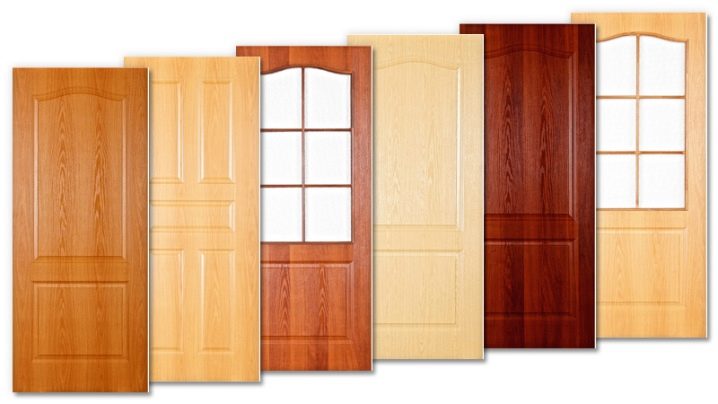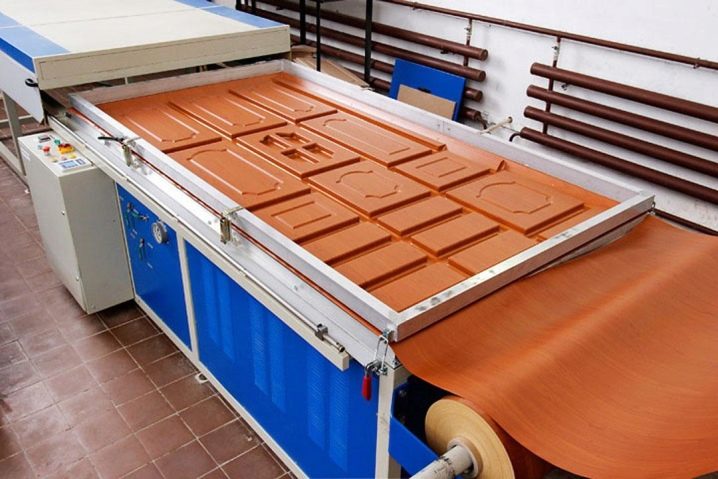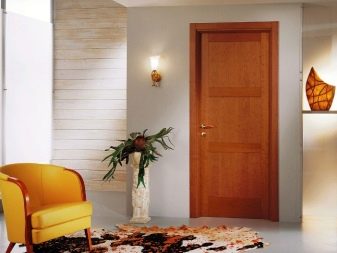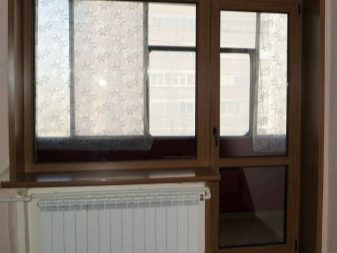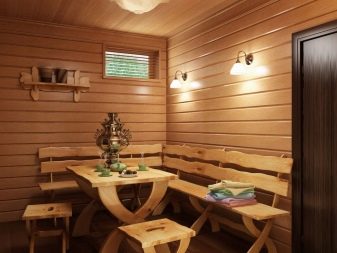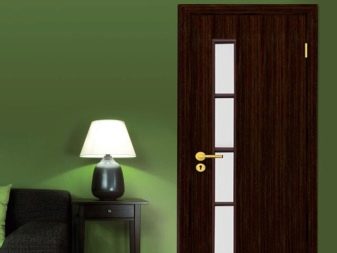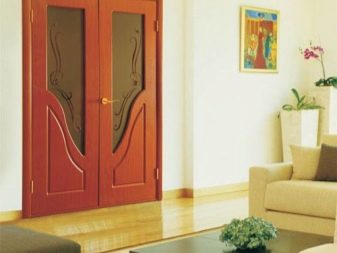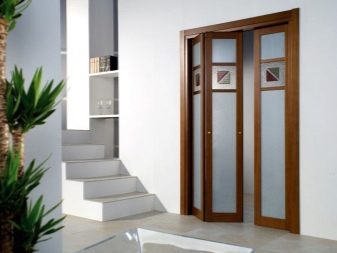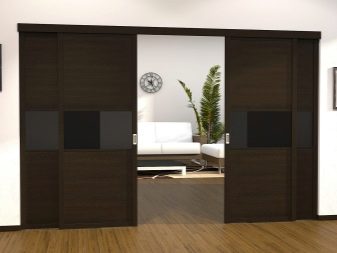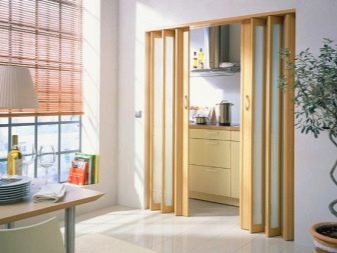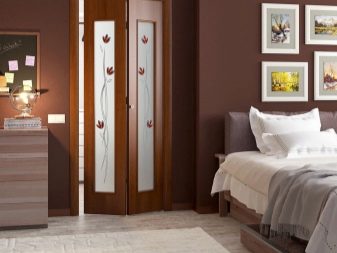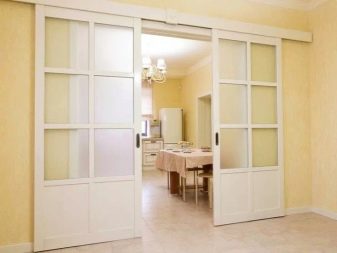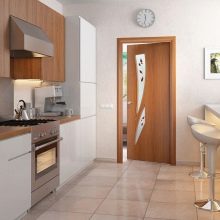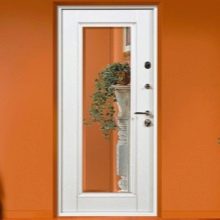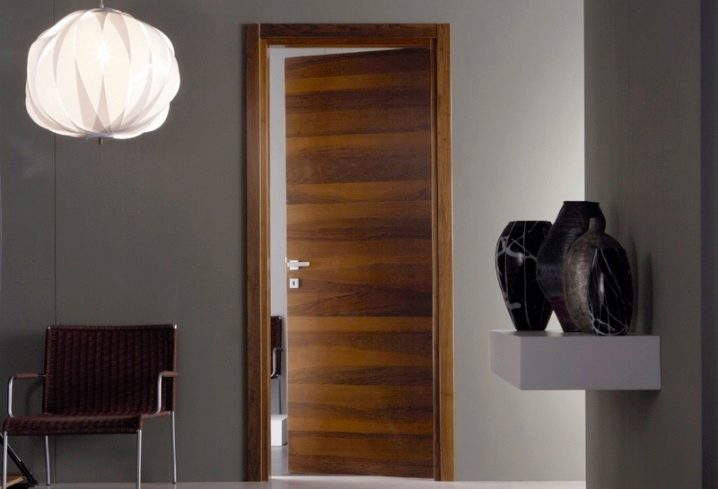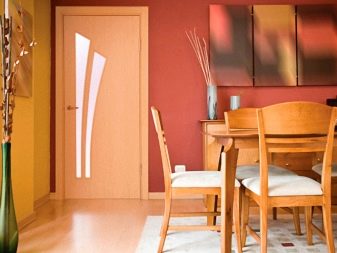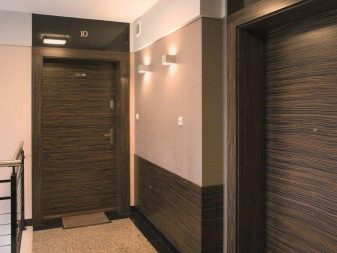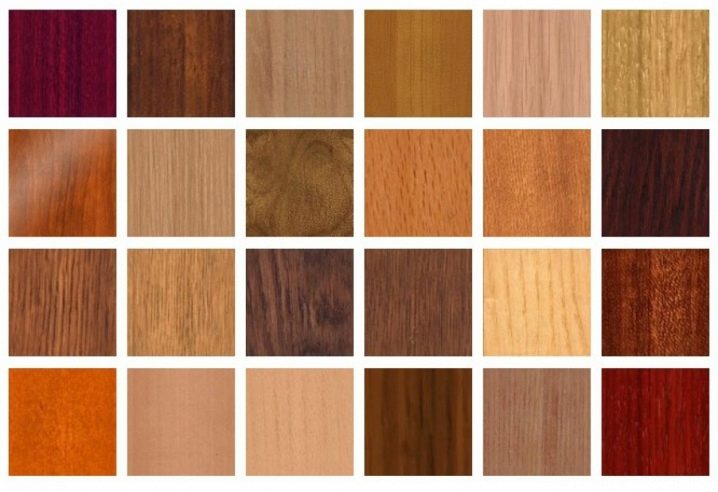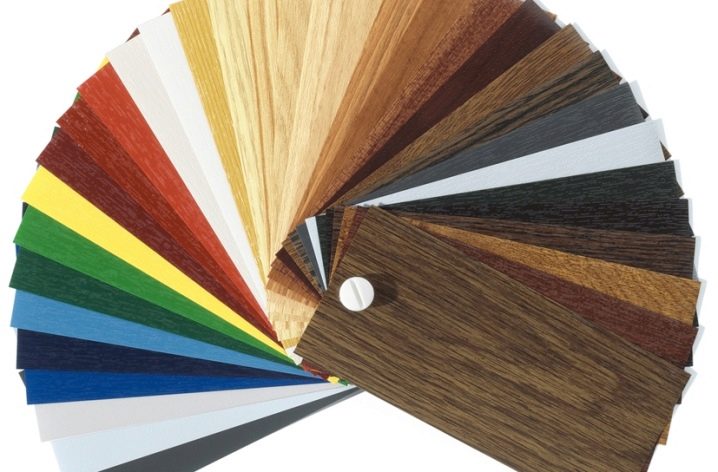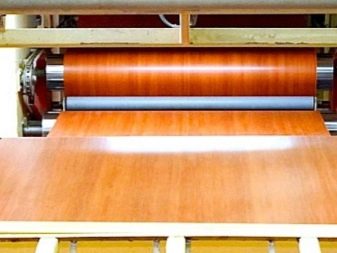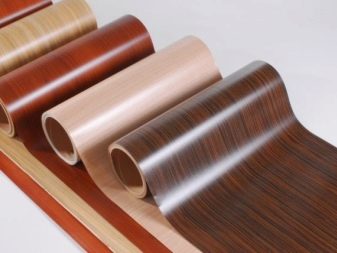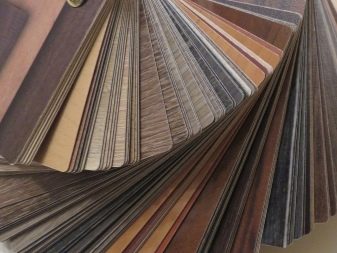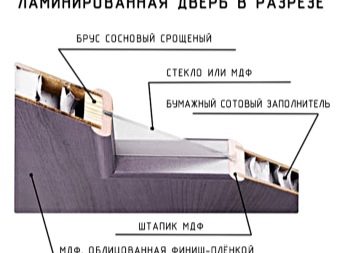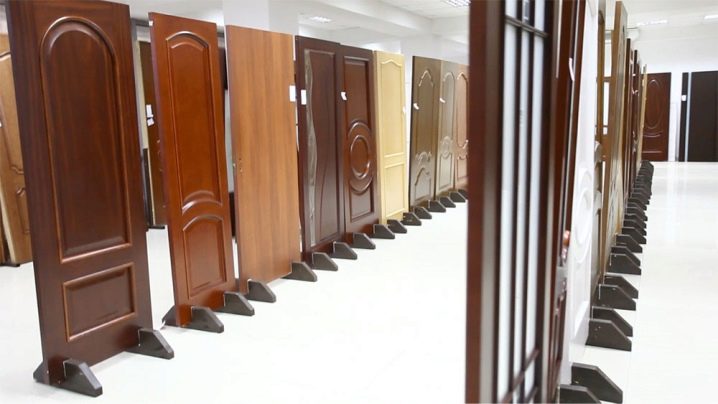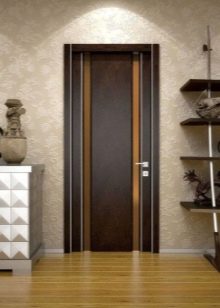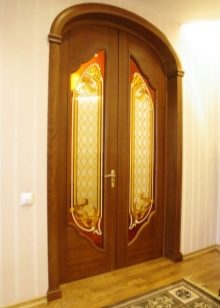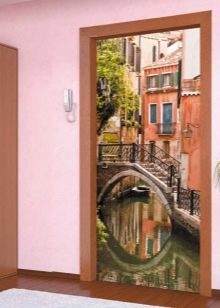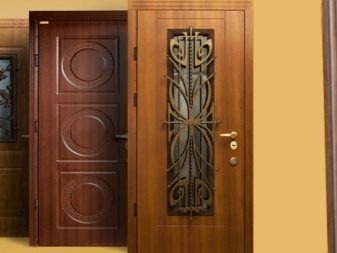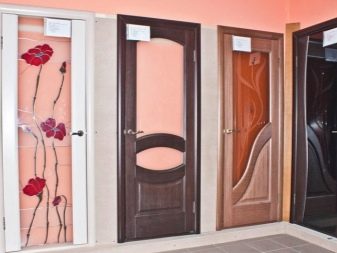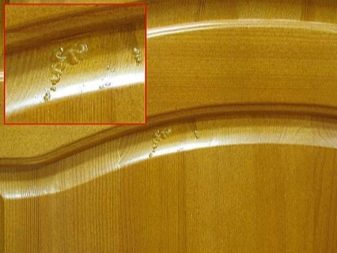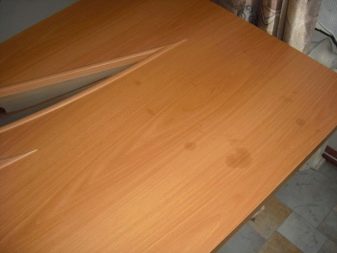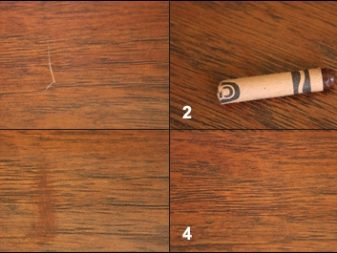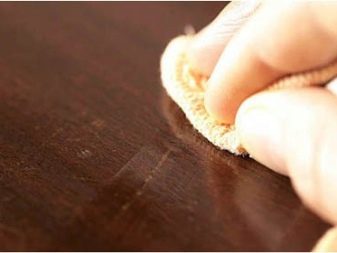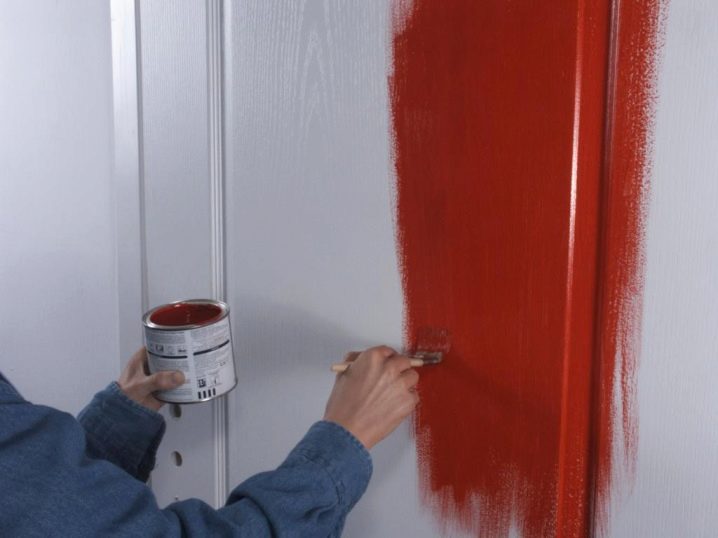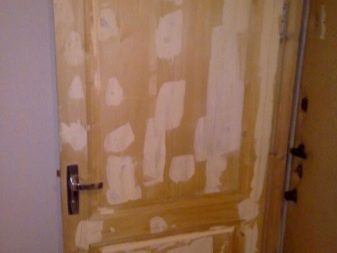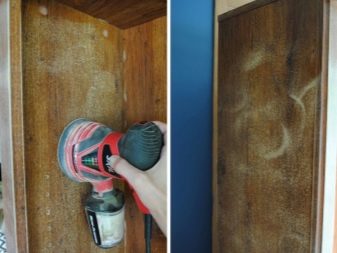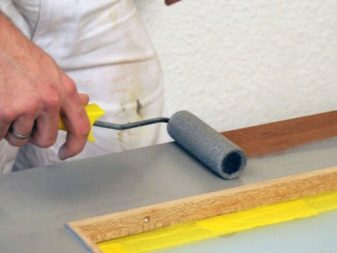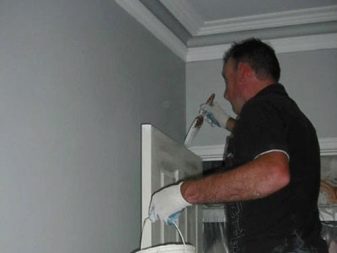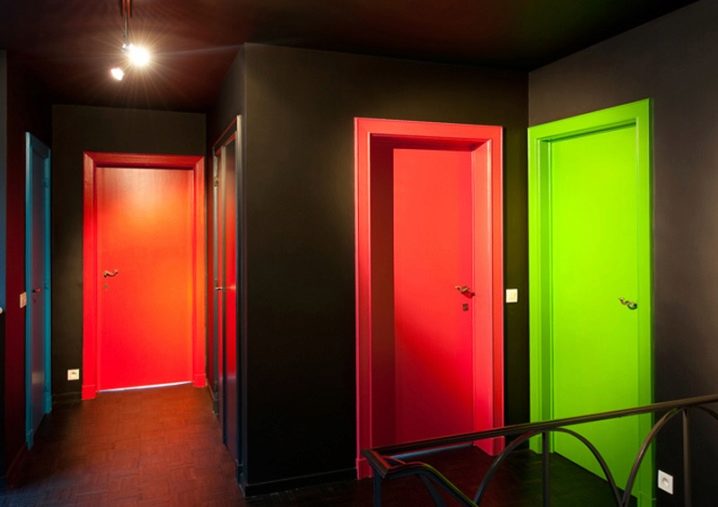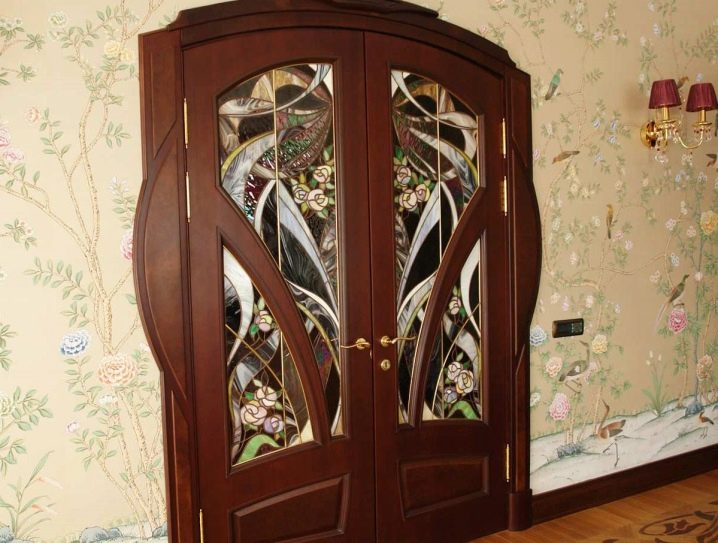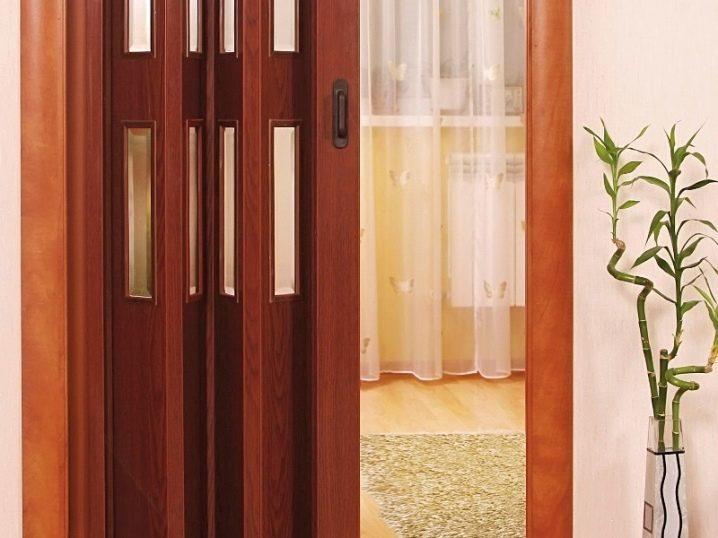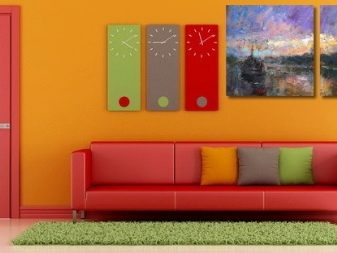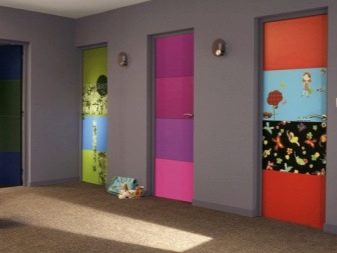Features of laminated doors
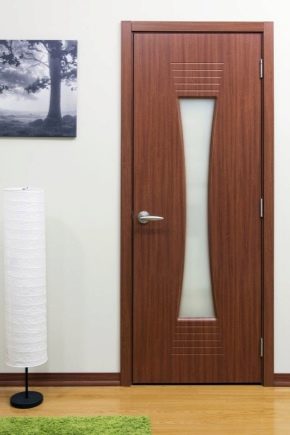
Having taken care to choose the door, more and more buyers are paying attention to the laminated products. Therefore, it is necessary to find out what it is, how they differ from other types and what are the features of laminated doors.
What is laminate flooring?
Imagine a door leaf in the production process. In itself, it does not look particularly attractive. To give a decent look to such a product, it must be painted or pasted over with a special film. Here it is called laminate, or laminate, and the process of pasting is lamination or lamination.
Kinds
Depending on their purpose, laminated doors are:
- input,
- balcony,
- interior,
- for bath and sauna.
By the number of wings door blocks do:
- single doors,
- bivalves,
- tricuspid
- four-leaved.
According to the principle of opening are divided into:
- swing
- sliding,
- folding,
- "harmonic".
In appearance may be:
- deaf
- with glass inserts,
- with a mirror.
According to the material used they are:
- wooden,
- metal,
- plastic,
- from chipboard,
- from plywood,
- from MDF.
The size of laminated doors can be standard and non-standard. Standards of doors are fixed with GOST, including size.
Depending on the purpose, door leafs of standard sizes have the following dimensions:
- Entrance doors: 205 by 98 cm or 210 by 98 cm, 205 by 88 cm. Double-wing door blocks have the following dimensions defined by state standard specifications: width - 191-195 cm, height - 237-245 cm.
- Interior and balcony doors according to GOST are defined by the following dimensions: height - 210 cm, width - 70, 80, 90, 100 cm. Double-wing blocks have the same height, but with a width of 130, 150, 170, 190 cm.
The remaining types of doors are non-standard. And the entrance and interior door blocks for private and country houses are also non-standard.When determining the size of your future news, you should remember that the size of the door is not the size of the canvas, but the size of the box. Even a standard doorway in an apartment requires careful measurements before purchase, and not only the height and width of the opening, but also the thickness of the walls.
By color, laminate can also be divided into standard and non-standard. The standard is white and what is called "under the tree." White laminated door leaf is a classic, used on both entrance and balcony and interior products. But manufacturers are trying to diversify their products. That is why now films with natural coloring have become traditional: chestnut, black cherry, dark oak, walnut, bog oak, mountain pine, Oregon, mahogany, wenge, etc.
But at the request of the customer, the door with lamination can have any color, including drawings and photographs. Such a film will not only significantly increase the cost of the door unit, but also decorate any housing.
And yet, all the above criteria do not define the main thing - whether any type of laminatin is suitable for an entrance or balcony door or not.You should also find out which laminate is better for interior and bath doors. Before buying, you need to determine not only the type of the laminated door, but also the look of the laminate itself.
Types of laminate
Laminate varies in composition and density. From this depends on its durability, reliability, cleaning characteristics. Manufacturers offer the following types of film:
- Paper - the cheapest and short-lived. It can only be used indoors. She quickly wears down, it is difficult to care for her.
- Melamine - paper from a large number of layers, soaked in synthetic resin. Such a laminate withstands mechanical and chemical effects much better, due to which the duration of its service increases.
- Fiberglass - The connection of the finest glass fiber and melamine. This film infrequently laminates the canvas because of the high cost of the film. At cost, this door can be compared to natural wood or veneered.
- Two-volume Outwardly, it is very similar to veneer, which is why it was called “artificial veneer”. At the moment, it is considered the highest quality type of laminate: durable, preserves aesthetic appearance for a long time, is resistant to moisture,temperature extremes, chemical effects, but also the price has a high.
- Polyvinyl chloride (PVC). Experts believe that the name "PVC door" is incorrect, because PVC is the outer coating (that film) of the door leaf. These are perhaps the most popular doors: lamination makes them reliable to mechanical and chemical damage, temperature extremes and water exposure. In addition, the popularity of these products is associated with their democratic price and great color diversity.
- CPL plastic coated - this is a more technological modification of PVC, which allowed to create a plastic laminated door. The film of continuous pressing has high wear resistance. More often it is used on entrance doors.
Which is better to choose?
Realizing the difference between different types of laminate, you need to think about the functions that will be entrusted to the door unit: protection against burglary at the entrance door, the possibility of ventilation for the balcony, convenience and aesthetic appeal for interior, water-repellent properties and ease of closing for the bath. From this will depend on the choice of future purchase.
At the time of inspection it is necessary to pay attention to the following:
- The material of the door frame and canvas. Whatever beautiful laminate is, the quality base is very important. For entrance structures, the most reliable is a metal door. For the interior - thin MDF, for the balcony - plastic panels.
- Laminatin type is very important. It should be clarified what film is covered with the product: paper, melamine, fiberglass, two-dimensional or PVC.
- Be sure to check the quality of pasting cloth and boxes. Detachment and bloating are not allowed.
- Edge should not be stratified. High-quality edging looks like a smooth smooth surface.
Door leaf should not make different sounds when knocking - this is a sign that the filler is evenly distributed.
- The low price of the product will indicate that it is suitable only for indoor use. No matter how beautiful such a door is, it can freeze or get wet on the street and balcony.
- Production of door structures is very widespread, so unscrupulous manufacturers use environmentally hazardous material for the manufacture of doors.Do not hesitate to ask a certificate of quality for the products, so as not to pay later with their health.
It is imperative to check the guarantees provided by the seller and the manufacturer in order not to overpay for the failed accessories or swollen laminate.
Design
The door leaf and box can be made of any size and shape, then there are almost no restrictions for any design idea.
The door unit can be decorated as follows:
- Choosing a non-standard form. Interior doors in a wide doorway can be an "accordion". This will save space for the valves and decorate the room. Another option is an arched design. It is suitable for both single and double doors. Atypical geometric door figures will be a symbol of modern styles.
- A door for any purpose can be not only rectangular, but also radial (radial). Such a design, of course, will be expensive and custom-made.
- PVC film, having a large color choice, will paint the canvas in high-tech or modern style.In this case, such a laminate can be not only monotonous, but also multi-colored, with a pattern or photo printing.
- Manufacturers offer a huge variety of glass inserts of various configurations. The glass itself can be transparent, frosted or colored, smooth or corrugated.
- On the front door from the inside make mirror inserts in the form of different geometric shapes. This door is interesting, it visually enlarges the hallway, but it can be short-lived.
- Provence style has small windows instead of a single glass sheet. This can be achieved with the help of special plastic or metallized tapes glued to the glass.
- A mirror reflective film glued onto the glass will decorate the laminated door, made in gray or blue color.
- Forging is the most beautiful element of the decor. It can be used both on the entire door leaf, and only on the glass insert.
Advantages and disadvantages
Like every product, laminated doors have their pros and cons.
Positive qualities are:
- Aesthetic appearance.
- Large color variety of laminating material.
- A large number of options for the design of the door leaf.
- High resistance of the material to the negative effects of moisture, high and low temperatures (as opposed to natural wood).
- High level of noise insulation.
- High-quality insulation.
- Good tolerance to mechanical damage (high quality film).
- Easy to maintain (non-paper laminate is easy to clean with ordinary detergents.)
- The low cost of laminated doors of economy class.
- Plastic products are lightweight, which means that they are easier to install.
- The use of laminate allows you to save trees, because door leaf is often made of wood waste.
The disadvantages of such products include:
- Environmental friendliness depends on the good faith of the manufacturer. But in any case, such doors lose wooden.
- Cheap doors will play in appearance, impact resistance. Full of chipboard, plywood, covered with paper film can not take out a mechanical shock, the dent is not subject to recovery.
- Economy version of laminated doors fade in the sun, and the film may eventually peel off.
- The MDF door frame may be thin and deform from moisture and temperature extremes. To prevent this from happening, the structure is reinforced with metal corners.
The usual rectangular laminated door looks quite simple. To give it an attractive appearance will require additional design efforts.
- Due to the small amount of filler in budget canvases, they are poorly suppressed by noise.
- In the houses, claiming the title of "palace", this door will not be on the status, although it may have a very attractive appearance.
- Wooden interior doors, coated with varnish, will emit the smell of natural wood and varnish. Any doors covered with laminate, will emit a chemical smell in one or another quantity.
- Door blocks made of MDF, chipboard is easier to replace than repair.
- Over time, the film may disperse at the junction points, and air bubbles will appear on the canvas.
Yet the advantages and disadvantages are largely dependent on the quality of products. Do not save on the subject, which can be used for more than a dozen years.
Tips
Smooth laminated film is easy to clean from ordinary dirt and dust.Wash off stains easily with a regular soft cloth and soapy water. More complex contamination washes away the water-alcohol composition (9: 1 ratio) or dishwashing liquid. To remove grease, oil stains, traces of coffee, etc., you can use soap or a stronger tool - ethyl or ammonia.
A large amount of water is not required for this, which means that the laminatin will not be affected. But in an emergency situation, when boiling water fell into the joints of the film and between the elements, the laminate can go blistering.
To prevent this from happening, the door leaf must be thoroughly wiped out, and the door left open so that it dries faster.
For long-term preservation of doors they are regularly treated with furniture polishes. Such a tool in its composition should contain wax. Processing polish once or twice a year will make the door glossy and hide micro-scratches. Door panels in wet areas (bath, shower, sauna, bath, kitchen) are best treated three to four times a year. You can try to hide the deep scratches with a wax pencil, which is preheated, waxed on the flaws and polished with a soft cotton napkin.
Ideally, once a year it is necessary to remove the door leaf to clean, lubricate and adjust all accessories. If necessary, then attach the bottom end of the door, which is most affected by wet cleaning and mechanical impact.
But if, nevertheless, the door has lost its appearance, then the owner asks the question: can it be painted? It turns out you can. But the canvas will have a completely different look and you can call it laminated very conditionally. To paint the old door, if it is smooth and the paint does not fall on it, home craftsmen have developed a whole technology.
To cover the paint of a laminated door, you will need to use a rag, sandpaper with various grains, a spatula, putty on wood, white spirit, PF-115 enamel or PF-226, and a brush.
- The first stage is surface preparation.. Thoroughly wash and dry the door. Using sandpaper or a grinder to level the surface. Dust remove a clean cloth.
- The second stage - applying putty. Spread the mixture all over the canvas with one or several layers. To putty does not crack, wait for the complete drying of each layer.After complete drying, treat the surface with medium-grained sandpaper.
- The third stage is matting. Wipe the cloth with a clean, dry cloth. Fine-grained sandpaper mat the door. It should be slightly rough, which will improve the adhesion of putty and paint.
- Fourth stage - to wipe the entire surface of the canvas with a soft cotton light monophonic cloth moistened with white spirit.
- The fifth stage - painting with a paint brush. in several layers. Enamel brand PF shines very beautifully, but do not rush to the application of a repeated layer - the enamel should dry well.
If you want to give the door even more shine, you can varnish it in one or several layers.
Options in the interior
Stunningly beautiful laminated door of irregular shape with inserts-stained glass. Such an interroom door in itself is an element of decor, and when the light is on, pleasant diffused light will penetrate through the stained glass.
Door - "accordion" is rarely used in the interior. And in vain. Small rooms, it is very suitable, because it requires little space. The canvas can be both deaf and with inserts.Depending on the functionality of the door glass set transparent, frosted or colored.
Bright, attractive, unusual, beautiful - these are the emotions that cause such a beautiful door.
The options for laminated doors are many. The main thing is to determine the criteria, prepare the necessary amount of money and a good mood for the optimal choice.
On how to determine the quality of the lamination of the door, see the following video.
